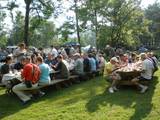March 30, 2011 GUEST BLOG POST by Melissa VanAlstyne
 “I have work to catch up on”, “I’m not hungry”, “I’m going out”, we have all heard these excuses when it comes to sitting down to a family meal and often it seems easier to just forgo it all together. However, research is proving just how big of an impact family meals do have. Not only is sitting down to a family meal a good way to keep the family connected but it also has a number of health benefits as well, one of which is promoting healthy eating habits among adolescents.
“I have work to catch up on”, “I’m not hungry”, “I’m going out”, we have all heard these excuses when it comes to sitting down to a family meal and often it seems easier to just forgo it all together. However, research is proving just how big of an impact family meals do have. Not only is sitting down to a family meal a good way to keep the family connected but it also has a number of health benefits as well, one of which is promoting healthy eating habits among adolescents.
According to a journal article in the Journal of Adolescent Health [full citation below] having a family meal can help to detect early signs of disordered eating as well as help prevent disordered eating from ever beginning. Having a family meal allows adolescents to see their parents engaging in healthy eating habits and therefore model their own eating habits after them. In addition, eating together allows parents to monitor their children’s diet which allows them to detect signs of disordered eating earlier.
While simply prioritizing sitting and eating together is good in and of itself, family meals should be times that parents and children value and find enjoyable. This means keeping discussion at the meal free from conflict around food or other issues, thus making the meal something the family looks forward to each day.
While life is undoubtedly extremely stressful and busy and finding time to sit down and eat together may seem a daunting task, the benefits of making sure to prioritize this family time cannot be overstressed. Adolescents who report more frequent and enjoyable family meals have been repeatedly found to be at a decreased risk for engaging in unhealthy weight control behaviors. So find a time that works for your family, sit down, pass the chicken and enjoy!
Fulkerson, J. Neumark-Sztainer,D. Story, M. Wall, M.(2004).Are Family Meal Patterns Associated with Disordered Eating Behaviors Among Adolescents? Journal of Adolescent Health,35. 350-359













